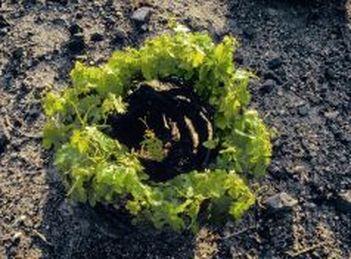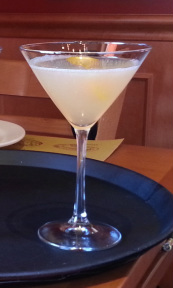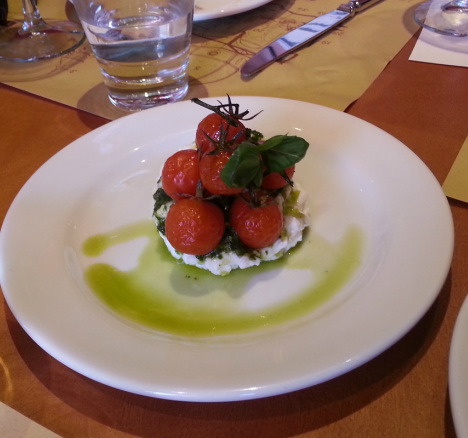 Did you know there are Grand Cru Rosés? Did you know there are Grand Cru Rosés? If you are familiar with some of my blog posts, follow me on Facebook or Twitter, than you most likely know that I adore France and, in particular, French Rosé. After spending the weekend at the Wine Bloggers Conference, I returned home with an idea - to create a website and blog devoted entire to Rosé. Not just the wines, but everything about them - their history, who makes them, where they make them and how, what foods pair well and where can you travel to taste them. I am pleased to introduce "The Rosé Rules". There's not much content at the moment - she's only a few hours old - but there will be soon. I invite you to stop by and visit and please feel free to tell me what you'd like to know. Cheers! www.theroserules.com
0 Comments
The recipe seems simple: take 2 award winning chefs and one acclaimed restaurateur. Blend with high quality sustainable ingredients, sprinkle liberally with lots of creativity and serve with class. The result: Pizzeria Mozza! A Southern California favorite since they opened the original Los Angeles restaurant in 2006, it seemed only fitting than when owners Nancy Silverton, Mario Batali and Joe Bastianich were seeking a location for their new San Diego incarnation, they selected a slice of local social history – the “Headquarters” at Pacific Coast Highway and Harbor Blvd. From 1939 to 1987 this was the original home the San Diego Police Department. And a stylish complex it was, with a typically SoCal mix of architectural styles, ranging from Spanish Colonial and Pueblo to Classical. The buildings have been beautifully restored, befitting it’s stature on the National Register of Historic Places, with fountains and shaded courtyards mingled with commercial spaces. Pizzeria Mozza, with its respect for history and tradition - enhanced by a modern twist- is a perfect fit for the location. There are four Pizzeria Mozza locations: Los Angeles, Newport Beach, the Marina Bay Sands in Singapore and now San Diego. Each restaurant shares the same philosophy summed up in this quote from Nancy Silverton : “ Simple, all natural ingredients lead to artful nutrition”. This location is green certified and procures its products from green oriented suppliers. Even the sparkling water is produced ‘in house’.  There’s a spacious outdoor patio (great for people watching on Sunday’s during the Certified Farmer’s Market!) and an inviting interior dining area. Several months ago I was invited to a Press Lunch for the International Food, Wine and Travel Writers Association. We had a chance to not only sample some of the classic dishes from Pizzeria Mozza but also to meet many of the people who make it all happen
 Our host, Sommelier LaMont Schroeder Our host, Sommelier LaMont Schroeder The menu also features a host of local San Diego draft and bottled beers and a creative wine list focusing on, not surprisingly, Italian vino. Many are from organic, smaller wineries that you won’t see on your average wine list. All have been chosen with the menu in mind and we can thank Sommelier LaMont Schroeder for that!  Authentic Bruschetta Authentic Bruschetta Each incarnation of Pizzeria Mozza shows a bit of it’s own personality, especially San Diego. With ever changing menu items to suit the season and the chef’s creative streak you could come back time and again and always find something new. There are, however, some classic staples and we were thrilled to sample them all. We began with a selection of Bruschetta -White Beans alla Toscana with Saba and Chicken livers, capers, parsley and pancetta. The bread was perfect – toasty but not so crisp as to shatter into a hundred pieces when you bit into it! The texture of the white beans was amazing and the savory liver was brightened by a hint of lemon and fresh parsley.  Chef John Stenbakken Chef John Stenbakken Chef John Stenbakken explained that the Bruschetta are a menu tradition, but the toppings are rotated on a regular basis. Everything is made in house – an important element in maintaining consistent quality. John has been with the company for may years and plans on adding more pasta dishes and grilled items to the menu. Our next course was a huge plate of gorgeous Pane Bianco, dripping with high end olive oil and garlic – the perfect compliment to probably the most beautifully presented Mozza Caprese I have ever seen! The small ‘on-the-vine’ tomatoes were roasted for about 2 – 21/2 hours to concentrate their sweet flavors and worked really well with the ultra creamy Burrata and fresh pesto. To cleanse our palates, a colorful Insalata Rosso was served. Crisp radicchio dressed with a simple lemon vinaigrette, delightfully ‘chewy’ Wisconsin applewood bacon, freshly shredded Peccarino Romano and softly cooked egg. I could have made a meal of this with some of that wonderful Pane Bianco!  You have to try the Pizza! You have to try the Pizza! But we couldn’t stop without trying some pizza! The ‘signature’ pizza, unique to San Diego, is the Kale Pizza. Beautifully balanced toppings of fresh baby kale, savory red onion, ricotta cheese, mozzarella and spicy coppa adorned the light, crispy, crust. Delicious.  Pastry Chef Juli Sinning Pastry Chef Juli Sinning We were introduced to pastry chef Juli Sinning, keeper of the secret dough recipe! Julie started with Pizzeria Mozza four years ago in their Singapore location and was brought out to San Diego to open the new restaurant. Although she could not be bribed to divulge all the secrets of this fantastic pizza crust, she did explain that they make all the dough by hand, twice a day – once in the morning and again in the afternoon. The dough will sit overnight which aids in developing the texture and flavors. Wood fired ovens at incredibly high temperatures bake the pizzas in a matter of moments and give them that distinctive deep color. Julie is also in charge of the terrific dessert selection. She makes all the Gelato from scratch using a special machine imported from Italy and they even squeeze their own fresh fruit juices to go into the house prepared sorbets. We were lucky enough to sample some of these cool, creamy confections: a hazelnut gelato and the pineapple/coconut sorbet. Refreshing, vibrant and true flavors shone through. These contrasted with the other signature dessert – the Butterscotch Budino – a decadently creamy pudding topped with burnt sugar, softly whipped cream, and Maldon sea salt. Sinful. The accompanying pine nut and rosemary biscuit was a savory addition to the sweet and salt of the pudding. Wow. Whether you visit Pizzeria Mozza for a quick ‘slice’ and a beer or spend several hours sipping your wine and savoring multiple courses, you are sure to leave this terrific location knowing you celebrated “La Dolce Vita”.
Pizzeria Mozza is located in the “Headquarters at Seaport District”, 789 West Harbor Blvd, San Diego 92101 (609) 376-4353 http://www.pizzeriamozza.com/SanDiego/home.cfm http://theheadquarters.com/shop-dine Parking: There are two lots at Seaport Village, across the street, Valet Parking at the Headquarters and metered parking on surrounding streets. Disclosure: Wine tasting is a highly individual experience and, scientifically, none of us perceive wine in exactly the same way. The opinions expressed in this post are mine and mine alone and although the wines sampled were supplied by the designated wineries for review I describe them as I see them.  The connection between the grapevine and Greece is almost as old as wine itself. The ancient Greeks spread viticulture throughout the Ancient World and, for them, wine was not just a commodity but life and culture as well. So with this long history in mind, it was with great excitement that I joined with other members of the Temecula Wine Council to sample five wines kindly supplied by the “New Wines of Greece”. For many of us, when we here “Greek wine” we immediately think of ‘Retsina’, perhaps crafted in rustic old wineries from grapes we can’t pronounce! I am glad to report that nothing could be further from the truth. There has been a mammoth revival in the Greek wine industry, beginning in the late 20th century. Many local winemakers, who ventured to wine producing areas throughout the world, have returned to their roots, building shiny new production facilities that rival those of the ‘New World’. While embracing many new winemaking techniques there is desire to blend them with time-honored philosophies such as biodynamic and organic viticulture and the use of indigenous grape varieties. And so, we gathered at the Dorland Mountain Arts Colony, just outside Temecula, CA. The fresh air and solitude made for the perfect venue. Each of the six members attending the tasting were assigned one of the wines and asked to prepare a compatible dish for everyone to share. As you will discover, much of the fare paired well with many of the wines, showing just how food friendly and versatile these vintages turned out to be! First up was “Thema 2012” from Pavlidis Estate near the Macadonian town of Drama in northern Greece. A 50/50 blend of Sauvignon Blanc and Assyrtiko, (ah-SEER-tea-ko) the wine is a prime example of old meets new. The region of Macadonia has been a prime grape growing area for millennia and founder Christoforos Pavlidis has been cultivating both native and international varieties since 1998. The winery embraces modern viticulural practices on its 148 acres planted on a variety of soils in two vineyard sites. The winery itself is state of the art and visitors are welcome in their modern tasting room located on the “Wine Road of Dionysus”. The wine was delightful, with a subtle, elegant nose of lemon cream enchanced with touches of fresh green herbs. The zippy acidity and lime zest flavor accentuated the saltiness of the smoked salmon brought to pair with it. Our second vintage came to us from the home of the famous Greek varietal, Assyrtiko – the Aegean island of Santorini.  courtesy New Wines of Greece.com courtesy New Wines of Greece.com Domaine Sigalas Assyrtiko-Athiri 2011 is another example of traditional grape varietals truly showing their ‘terroir’ through more modern production. Domaine Sigalas was founded in 1991 and by 1998 had constructed a brand new winery/production center near Ola, in the northern part of the island. Their 47 acres of vineyards are planted on volcanic soils comprised of cinders, lava and pumice. They specialize in indigenous grape varieties grown in the traditional manner unique to Santorini. Vines are trained low to the ground, woven around itself like a round basket. This format, called a Kouloura meaning wreath or basket, protects the vines from strong winds and also shields the grape clusters from the intense, direct sunlight. The wine was a prime example of how the local white grapes of Greece have evolved to withstand the heat and sun of the Mediterranean without losing any of their distinctive, refreshing acidity. The clean, citrusy aromas were a true indication of what was found in the glass! Amazing, racy, mouth-watering acidity combined with a slight hint of sea air minerality and touches of lime blossoms. It was a terrific compliment to the steamed artichokes in olive oil, herbs and seasonings; the wine acting like a spritz of brightness, bringing out the flavor of the vegetable and freshness of the herbs. The last white of the evening also hailed from Macadonia - Ovilos Estate Biblia Chora 2010 a blend of a traditional native grape (50% Assyrtiko) and an international variety (50% Semillon). Vineyards here were first planted by the Phoenicians who found this “Golden Mountain” while in search of precious metals. Alexander the Great mined gold here to finance his expeditions and the Cult of Dionysus (or Bacchaus to the Romans) made their wines from Macadonian fruit. But enough history! The winery’s founders both studied in Bordeaux and returned to their homeland to make wine. The original 70 acres were planted in 1998 and now there are close to 350, all of which are farmed organically. A modern winery, built to resemble a grand Bordelais Chateau, was built in 2001 and their efforts have paid off; the wines have won numerous awards throughout the world.  This blend had a beautiful brilliant gold appearance, reflecting the 8 months the wine spent in oak. The aromas were clean and fresh with notes of golden apple, soft fruit blossom florals and a suggestion of dried apricot. The palate was supple and honeyed showing touches of mango and toasted pine nuts. It went very nicely with the food I had paired – grilled chicken Breast with herbed zucchini stuffing. The wine lifted the herbaceous notes in the dish and surprisingly, also complimented the artichokes and another traditional dish – Moussaka. Next up was the first red,“Xinomavro 2008 Urano” from Thumiopoulos Vineyards in Naoussa, also located in Macadonia. This winery is owned by Apostolos Thumiopoulos who, at the tender age of 31, is acknowledged as the ‘rising star’ in this famous wine growing region, Naoussa. His vineyards, all biodynamic, are planted on complex soils – a mixture of marl, schist and granite - in the southern part of the appellation. The winemaker embraces a minimally invasive philosophy when it comes to making wine, letting the grapes express themselves and showing their unique character, vintage to vintage. He uses naturally occurring yeast and little, if any, filtration to produce terroir driven results. This wine, made from the native Xinomavro (ksee-NO-mah-vro) varietal, showed aromas of dark strawberry jam laced with white pepper and soft touches of toasty rye bread. Dried tomato and a slightly spicy note lingered on the finish. The tannins and acidity were nicely balanced, which made it a wonderful compliment to the tasty ‘Boubaria’ – a traditional meat sausage of the area, bringing out spicy notes of cumin. It also paired beautifully with the Moussaka and some decadent spiced fig cakes! Our final wine of the evening kept us in the appellation of Naoussa and was also an expression of Xinomavro –“2007 Boutari Grande Reserve Naoussa.” The name Boutari is a familiar one around the world. It is the regions oldest winery – its history goes back 130 years – and has been an ambassador for Naoussa, the Xinomavro grape and Greek wine for almost as long. The vineyards are on the south-east slopes of Mount Vermio where the grapes enjoy lots of sunshine, generous rainfall and are shielded from the cold northerly winds. The marl soils, a mixture of limestone and clay, give the wines their rich body and ageing potential. The Grande Reserve is one of Boutari’s most collectable red wines and this vintage still has room to mature. Prune, plum and baking spices abound on the nose and palate with ripe dark berries and vanilla hanging on through the finish. The tannins are still firm and the acidity bright. Definitely a wine you would want to cellar or use a decanter or aerator to enjoy now. Also on hand was a fantastic Greek dip – feta, oregano, kalamata olives, and sun-dried tomatoes – served with pita chips that went with a variety of the evening’s wines. And lest we forget to mention the sinful chocolate brownies – frosted no less! As expected, they were a treat with both red wines and made a suitable ending to our feast. It was a terrific and enlightening group of wines that made me want to go out and find other “New Wines of Greece” to explore and enjoy. As they say in Greece “Yia Mas” - Here’s to Health!  with Linda Kissam, 1st VP of IFWTA with Linda Kissam, 1st VP of IFWTA I am so excited to announce that I was selected as the recipient of the International Food, Wine and Travel Writers Association's (aka: IFWTWA) "2013 Emerging Writer Scholarship Award" This is such an incredible opportunity and I look forward to sharing my wine related adventures. Stay tuned! |
AuthorWine lover, educator and writer. Archives
March 2017
Categories
All
|








 RSS Feed
RSS Feed

